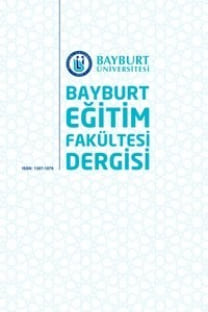4 ve 5. SINIF ÖĞRENCİLERİNİN BİLİM İNSANI İMAJLARININ KARŞILAŞTIRILMASI
bilim insanı, bilim insanı imajları, ilköğretim öğrencileri
A COMPARISON OF THE 4 AND 5. GRADE STUDENTS’ SCIENTIST IMAGES
scientist, images of scientists, elementary school students,
___
- Barman, C. R. (1999). Students’ views about scientists and school science: Engaging K-8 teachers in a national study. Journal of Science Teacher Education, 10 (1), 43-54.
- Bora, N. D., Arslan, O. ve Çakıroğlu, J. (2006). Lise öğrencilerinin bilim ve bilim insanı hakkındaki görüşleri. Hacettepe üniversitesi Eğitim Fakültesi Dergisi, 31, 32-44.
- Buldu, M. (2006). Young children’s perceptions of scientists: a preliminary study. Educational Research, 48(1), 121-132.
- Burton, G.M. & Huber, R.A. (1995). What do children think scientist look like?. School Science and Mathematiccs, 95 (7), 371-376
- Chambers, D. W. (1983). Stereotypic images of the scientist: The draw a scientist test. Science Education, 67 (2), 255-265.
- Ekici, F., Doğan, A. ve Kaya, O. N. (2007). İlköğretim ikinci kademe (6., 7., 8., Sınıf) öğrencilerinin bilim insanı imajları. Ulusal Fen Bilimleri ve Matematik Eğitimi Kongresi, Ankara.
- Finson, K. D. (2003). Applicability of the DAST-C to the images of scientists drawn by students of different racial groups. Journal of Elementary Science Education, 15 (1), 15-27.
- Finson, K. D., Beaver, J. B. & Cramond, B. L. (1995). Development and field tests of a checklist for the draw-a-scientist test. School Science and Mathematics, 95 (4), 195-205.
- Finson, K. D., Riggs, I. M. & Jesunatahadas, J. (1999, January). The relationship of science teaching self efficacy and outcome expectancy to the Draw-A-Science-Teacher Teaching Checklist. Paper Presented at the Annual International Conference of The Association of Educators of Teachers of Science, Austin, TX.
- Fort, D. C. & Varney, H. L. (1989). How students see scientists: mostly male, mostly white, and mostly benevolent. Science and Children, 26(8), 8 – 13.
- Gonsoulin, W. B. (2001). How do middle school students depict science ana Scientist. Mississippi State University, Curriculum and Instruction, Doctoral Thesis, UMI Number: 3005589
- Güler, T. ve Akman, B. (2006). 6 yaş çocuklarının bilim ve bilim insanı hakkındaki görüşleri. Hacettepe Üniversitesi Eğitim Fakültesi Dergisi, 31, 55-56
- Kahle, J. B. (1989). Images of scientists: gender issues in science classrooms. The Key Centre For School Science And Mathematics, 4, 1-9.
- Kaya, O. N., Doğan, A. & Öcal, E. (2008). Turkish elementary school students’ images of scientists. Eurasian Journal of Educational Research, 32, 83-100.
- Kibar-Kavak, G. (2008). Öğrencilerin bilime ve bilim insanına yönelik tutumlarını ve imajlarını etkileyen faktörler. (Yayımlanmamış Yüksek Lisans Tezi). Selçuk Üniversitesi, Konya.
- Korkmaz, H. ve Kavak, G. (2010). İlköğretim öğrencilerinin bilime ve bilim insanına yönelik imajları. İlköğretim Online, 9(3), 1055-1079.
- Korkmaz, H. (2004). The images of the scientist through the eyes of the Turkish children. Panhandle Science & Mathematics Conference, Canyon, Texas, USA.
- Küçük, M. (2006). Bilimin doğasını ilköğretim 7. sınıf öğrencilerine öğretmeye yönelik bir çalışma. (Yayımlanmamış Doktora Tezi). Karadeniz Teknik Üniversitesi, Trabzon.
- Lannes, D., Flavoni, L. & De Meis, L. (1998). The concept of science among children of different ages and cultures. Biochemical Education, 26, 199–204.
- Mason, C. L., Kahle, J. B. & Gardner, A. L. (1991). Draw-A-Scientist Test: Future implications. School Science and Mathematics, 91(5), 193-198.
- Mead, M. & Metraux, R. (1957). The image of the scientist among high school students: a pilot study. Science, 126, 384-390.
- Nuhoğlu, H. ve Afacan, Ö. (2007). İlköğretim öğrencilerinin bilim insanına yönelik düşüncelerinin değerlendirilmesi. 16. Ulusal Eğitim Bilimleri Kongresi, Tokat.
- Oğuz-Ünver, A. (2010). Perceptions of scientists: a comparative study of fifth graders and fourth year student teachers. Necatibey Eğitim Fakültesi Elektronik Fen ve Matematik Eğitimi Dergisi, 4(1), 11-28.
- Öcal, E. (2007). İlköğretim 6, 7, 8. sınıf öğrencilerinin bilim insanı hakkındaki imaj ve görüşlerinin belirlenmesi. (Yayımlanmamış Yüksek Lisans Tezi). Gazi Üniversitesi, Ankara.
- Song, J. & Kim, K.S. (1999). How Korean students see scientists: the images of the scientist. International Journal of Science Education, 21 (9), 957- 977.
- Türkmen, H. (2008). Turkish primary students’ perceptions about scientist and what factors affecting the image of the scientists. Eurasia Journal of Mathematics, Science And Technology Education, 4(1), 55-61.
- Yıldırım, C. (2005). Bilimin Öncüleri. Ankara: Tübitak Popüler Bilim Kitapları.
- Yontar Toğrol, A. (2000). Öğrencilerin bilim insanı ile ilgili imgeleri. Eğitim ve Bilim, 25(118), 49-57.
- ISSN: 1307-1076
- Yayın Aralığı: Yılda 4 Sayı
- Başlangıç: 2006
- Yayıncı: BAYBURT UNIVERSITESI
LA FONTAINE’İN FABLLARINDA ALEGORİK ÖGELER VE BUNLARIN TEMSİL ETTİĞİ DEĞERLER
4 ve 5. SINIF ÖĞRENCİLERİNİN BİLİM İNSANI İMAJLARININ KARŞILAŞTIRILMASI
MESLEK LİSESİ BT ÖĞRETMENLERİNİN BT EĞİTİM PROGRAMI HAKKINDAKİ GÖRÜŞ, BEKLENTİ VE DENEYİMLERİ
OKULÖNCESİ ÖĞRETMEN ADAYLARININ ÇOKLU ZEKÂ ALANLARININ FARKLI DEĞİŞKENLERE GÖRE DEĞERLENDİRMESİ
Özlem AKSU, Murat AKTAŞ, Ahmet GÖKMEN, Gülay EKİCİ, Hülya GÜLAY OGELMAN
TÜRKÇE ÖĞRETMENİ ADAYLARININ EĞİTSEL İNTERNET KULLANMA ÖZ YETERLİLİKLERİNE DAİR İNANÇLARI
Behice VARIŞOĞLU, İsa YILMAZ, İzzet ŞEREF
Gökhan DEMİRCİOĞLU, Hülya DEMİRCİOĞLU, Merve ALTUNTAŞ AYDIN
SINIF ÖĞRETMENLİĞİ VE FEN BİLGİSİ ÖĞRETMEN ADAYLARININ EĞİTİM PSİKOLOJİSİ DERSİNE İLİŞKİN GÖRÜŞLERİ
İSLAM’IN AKILCI EKOLÜ MU’TEZİLE
WEB TABANLI ÖĞRETİMİN FEN VE TEKNOLOJİ DERSİ ÜZERİNDEKİ ETKİSİ
